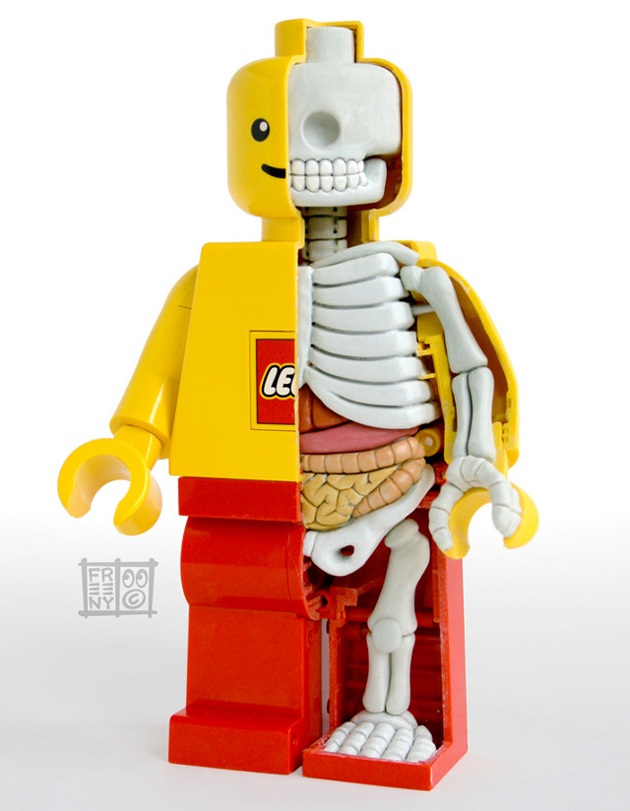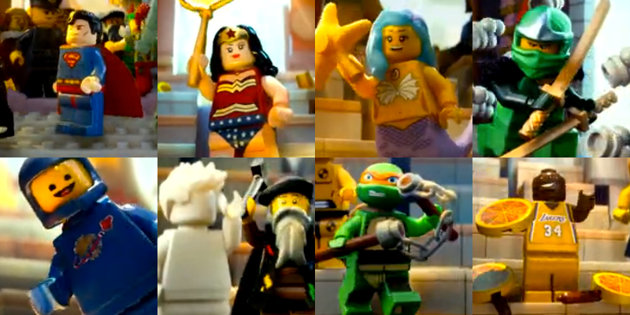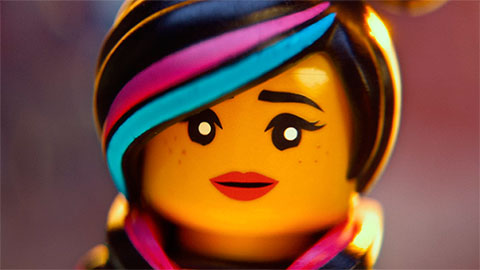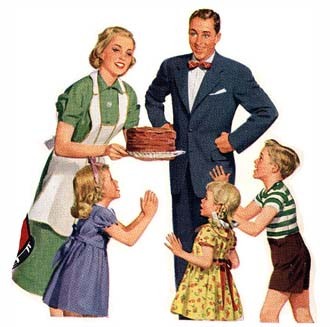
Artist Jason Freeny's LEGO Anatomy Model
Image Credit: hiconsumption.com
In my last post, I laid out the theoretical groundwork of biopolitics for a critique of the subversive potential of the LEGO movie. Biopolitics, or the epistemological and sociopolitical forces that determine how individuals understand bodies and “life,” lets us examine both the LEGO movie's own critique of social constructivism and comment on the movie's failure to adequately separate itself from static models of gender and sexuality.
The movie looks most promising in its progressive depiction of the positive biopower of the multitude. First of all, the revolutionary potential of the LEGO Movie is distinctly global in scope. Individuals from radically different worlds comprise the heterogeneous, but unified, community of Master Builders. This representation suggests that big business and corrupt politics can be overcome only by spanning various ways of life and drawing energy from multiple cultures. Hardt and Negri argue that despite Empire's dominating, international reach, the negative impact of globalization might be countered by a new, post-proletariat class, the multitude. These laborers are linked together through their mutual exploitation under the power of Empire, but these very powers that exploit them facilitate community formation. In the LEGO Move, of course, Lord Business attempts to segregate the worlds. His oppressive power in each realm, however, inspires Master Builders to come together despite the borders between their worlds.

The Master Builders
Image Credit: Yahoo! Movies
Secondly, the very structure of this universe serves as a perfectly apt metaphor for the subversive potential of the multitude. Lord Business builds his Empire out of LEGOs, constructing what appear to be stable landscapes, buildings, and, less concretely, paradigms and daily routines for his citizens. These backdrops, however, can be dissassembled by Master Builders, individuals with the amazing capacity to create structures without instructions, the imaginative heroes of the movie. Lord Business's ultimate act of villainy involves his plan to freeze the LEGO worlds in place using “the Kragle,” a secret super weapon (super glue, in fact) that will destroy the dynamism that makes the LEGO universe so promising.
Finally, the LEGO movie makes a truly sophisticated theoretical move (not to mention a savvy business move) in its counter-radical support of revolution from within the system. Hardt and Negri argue that multitude derives its energy from Empire, and can cause reform, even structural collapse, only from inside Empire itself. If Emmett learns about the joys of thinking outside the instruction manual, the initial political radicalism of the Master Builders gets sharply reined in. Essentially, Emmett proves to this group of visionaries that an individual following social codes has just as much creativity and imagination as the most talented Master Builder. In Wyldstyle's moving speech to the multitude, broadcast to all LEGO worlds from Lord Business's own communications system, she admits that institutions constructed by Empire have generated a truly creative, powerful populace. She says that Emmett was
a face in the crowd, following the same instructions as you. He was so good at fitting in no one ever saw him. I owe you an apology cuz I used to look down on people like that. I used to think they were followers with no ideas or vision. Because it turns out Emmett had great ideas. Even though they seemed weird and kind of pointless, they actually came closer than anyone else to saving the universe. And now we have to finish what he started by making whatever weird thing pops into our heads. All of you have the ability inside you to be a groundbreaker, and I mean literally. Break the ground! Peal up the pieces, tear apart the walls! Build things only you can build. To defend ourselves, we need to fight back against President Business's plans to freeze us!

I can change just about everything except my own name!
Image Credit: Lego.com
Unfortunately, this film fails to demonstrate that gender roles and sexuality are just as ripe for imaginative deconstruction as everything else in the LEGO universe. If part of the central message is that everyone, including “average” folks that revolutionary radicals might accuse of being brainwashed, is special, Emmett himself only aspires to greatness because of his attraction to Wyldstyle. In a conversation with her, he admits, “when you said I was talented and important, it made me want to do everything I could to be the guy you were talking about.” Even when Emmett meets Wyldstyle, the movie subtly highlights the liberatory potential of romance. Emmett first sees her digging around after hours at the construction site. He consults his instruction manual and reads aloud, “If you see anything weird, report it immediately. Well, I guess I'm gonna have to report y....” He break off because at this point Wyldstyle throws back the hood of her jacket and tosses her lovely LEGO hair. Emmett, completely arrested in his action by her beauty, watches her in awe. Sexual attraction, in this case, causes Emmett to unintentionally deviate from “the instructions.” Biopolitical critics like Foucault have pointed out that painting sexual fulfillment and romance as “subversive” only reaffirms the importance of sexuality and gender, a strategy that ultimately fails to imagine new possibilities since capitalist societies rely so heavily on the heterosexual family structure.
In addition, the movie ultimately breaks Wyldstyle down into Lucy, her “original” identity, a move I found just as inexplicable as it was disappointing. Emmett initially points out that “Wyldstyle” isn't quite a normal name, and this joke is played for laughs at multiple points. When Wyldstyle takes Emmett to Vitruvius, the prophetic Master Builder who originally predicted the rise of “the Special,” adds another, decidedly less humorous, angle to her name. When she identifies herself as Wyldstyle, he asks, “Are you a student I used to have who was so insecure she kept changing her name?” Watching this exchange, I became immediately flummoxed. This is the only point in the film where change is figured as a result of “insecurity” instead of creativity. Wyldstyle, a Master Builder, can take apart alleys to make motorcycles, but apparently she cannot take those sorts of deconstructive liberties with her own identity. Instead, she must admit that her name is “Lucy,” and, eventually, both Emmett and Batman (her brooding boyfriend) address her by this much tamer appellation. In a LEGO movie about the joys of breaking things apart, the satisfaction of putting them back together “incorrectly,” the glee involved with sticking dragons on luxury condo buildings, the female protagonist's primary arc involves rediscovering her “real” identity.

WHY, LEGO Movie? Just...Why?
Image Credit: examiner.com
I haven't had space this post to talk about the meta-level of the LEGO movie. All of the lovable main characters, in their fight against oppressive sociopolitcal and economic systems, are actually being controlled by humans, you know, playing with LEGOs. There's a lot more to say about this metafictional structure (does it completely undermine their rebellion?), but I'll only mention one irksome point. We never actually see any “female” players. The standard, white, middle-class family referenced here is comprised of “Dad,” the Lord Business-style bad guy, “the son,” the creative mind behind Emmett's rebellion against order, “Mom,” a voice upstairs upstairs whose only line involves calling Dad and Son up to dinner, and “the daughter,” a young girl who also obtains the right to play with Dad's LEGOs thanks to her brother's imagination and heart. The very safe heterosexual family here seemed so much like a cop out in a movie about reconfiguration, creative possibility, and the jouissance of chaos almost ruined this otherwise highly intelligent movie for me. Until I listened to “Everything is Awesome!” again. A quick fix for any disillusionment.




Recent comments
2 years 29 weeks ago
2 years 44 weeks ago
2 years 44 weeks ago
2 years 50 weeks ago
3 years 4 weeks ago
3 years 4 weeks ago
3 years 4 weeks ago
3 years 6 weeks ago
3 years 6 weeks ago
3 years 6 weeks ago